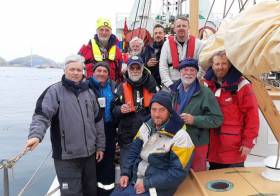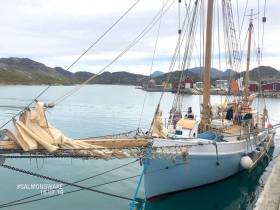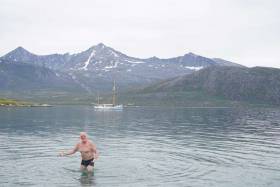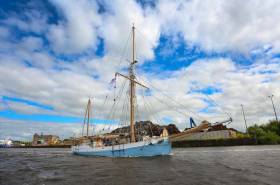Displaying items by tag: Ilen
Built as a Sailing Boat – the Unique Free State Fishing Boat
In recent podcasts I’ve reported on the Cork Harbour T Boats, a Class now extinct apart from the restored original boat, which I highlighted last week here; the successful revival of the Rankins; the restoration underway of the gaff-cutter Lady Min and followed the marvellous restoration of the Ilen, the last Irish trading ketch, now in Greenland's waters.
That was carried out at Liam Hegarty’s boatyard in Oldcourt, Skibbereen, on the River Ilen. It’s not far from there to Baltimore, where that port, a major sailing location these days, was a major builder of fishing boats and Skinner’s yard well-known.
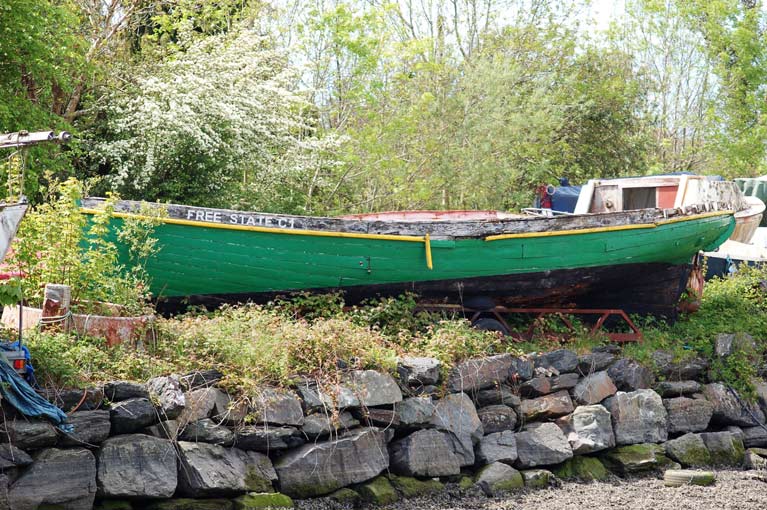 Free State C1 at Hegarty's Boatyard in Oldcourt Photo: Tom MacSweeney
Free State C1 at Hegarty's Boatyard in Oldcourt Photo: Tom MacSweeney
Back at Liam Hegarty’s yard, I came across a boat which had been built at Skinner’s and whose connections are historic to the founding of the Irish Republic.
Built in the style of a sailing boat, it became the first-ever boat to be registered as a fishing boat in County Cork, with a name that is outstanding – FREE STATE C1. So named because administrators of the emergent Irish State in 1922 apparently would not register it in Irish! So the family made their point with the unique name.
This is a story that has to be heard in the telling and was told to me by Eoin Ryan, himself a seafarer, whose family owns the boat that was “a super business venture in her time,” as he put it and also the first fishing boat, with sailing boat lines, built with an engine in place.
Listen to the podcast below
Limerick Ketch Ilen Exploring in West Greenland
While the restored 1926-built 56ft traditional trading ketch Ilen of Limerick may have arrived in the Greenland capital of Nuuk last weekend in harsh weather – albeit with a favourable southerly wind – since then conditions have become much gentler, providing ideal opportunities for local coastal exploration and continuation of the research programme into the migratory patterns of the Atlantic salmon writes W M Nixon.
It is this programme which has given the venture the overall title of Salmons Wake, and the arrival of summery conditions in Greenland has facilitated regular deployment this week of Ilen’s distinctive square sail, emblazoned with the distinctive Salmons Wake logo. Skipper Gary MacMahon of the Ilen Project reports on a rewarding three days:
 An iron coast….even in summery conditions, there’s no doubting the sheer ruggedness of the Greenland coast. Photo: Gary MacMahon
An iron coast….even in summery conditions, there’s no doubting the sheer ruggedness of the Greenland coast. Photo: Gary MacMahon
"After a magnificent three day trip to Umanap Surdlua and other adjacent fjords, the Limerick ship Ilen and her crew returned to Nuuk, West Greenland this evening (Wednesday). Umanap Surdlua is a vast Fjord area where we find Greenland's only salmon-spawning river, the Kapisillit, a river which is central to the Ilen Project’s Educational Programme - Salmon's Wake.
All on board are delighted with the achievement and results of visiting the Kapisillit River, and discovering at first hand the challenges it shares for the wild salmon with our very own river, the majestic Shannon. The research results and discoveries made will be presented in due course, on return to Limerick.
The Umanap Surdlua trip, in sheltered waters, also provided some excellent sailing and ship handling conditions. conditions which crew of Ilen crew did not waste, taking the opportunity to set every stitch of sail the ship carries”.
Today (Thursday 25th July) Ilen will be sailing north from Nuuk, and in time will cross the Arctic Circle.
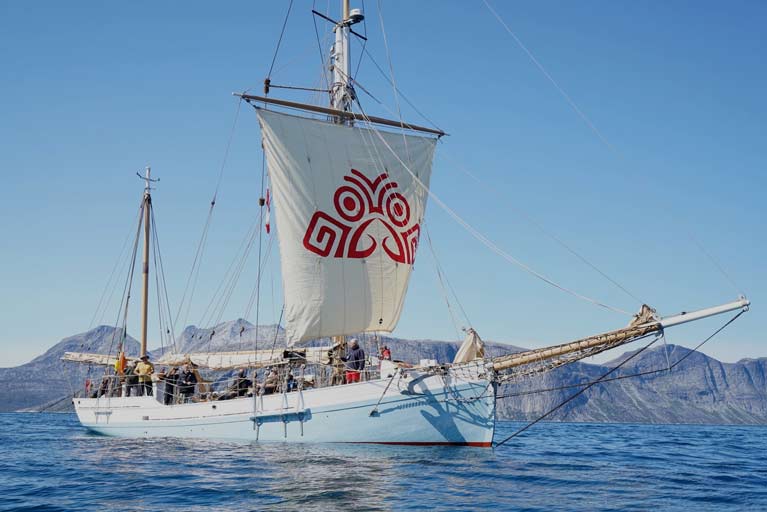 A well-earned spot of gentle cruising for Ilen’s crew. Despite a very rough rounding of Cape Farewell, Greenland’s most southerly headland, the restored 1926-built ship is looking very well indeed. Photo: Gary MacMahon
A well-earned spot of gentle cruising for Ilen’s crew. Despite a very rough rounding of Cape Farewell, Greenland’s most southerly headland, the restored 1926-built ship is looking very well indeed. Photo: Gary MacMahon That famously long Ilen bowsprit, made in the Ilen Boatbuilding School in Limerick and installed on the vessel at Hegarty’s Boatyard in Oldcourt near Baltimore in West Cork, finds an appropriately dramatic background with the Greenland coast. Photo: Gary MacMahon
That famously long Ilen bowsprit, made in the Ilen Boatbuilding School in Limerick and installed on the vessel at Hegarty’s Boatyard in Oldcourt near Baltimore in West Cork, finds an appropriately dramatic background with the Greenland coast. Photo: Gary MacMahon
After a swift but cold 26-hour run up the Labrador Sea along the southwest coast of Greenland from Paamuit, Limerick’s restored 1926-built 56ft ketch Ilen reached her primary destination, the Greenland capital of Nuuk, late this morning (Friday) writes W M Nixon. The crew were cold and tired but happy as they adjusted to the sensory assault of a busy modern port 19 days after leaving Limerick and taking their Irish departure on the afternoon of Monday July 1st from Loop Head, the northern sentinel of the Shannon Estuary.
With the first major stage of this year’s Salmon Wake voyaging now successfully completed, there will be time to further their studies and research into the migratory routes and methods of the threatened Atlantic salmon, whose returning numbers have fallen alarmingly in recent years on nearly all European rivers, including those in Ireland.
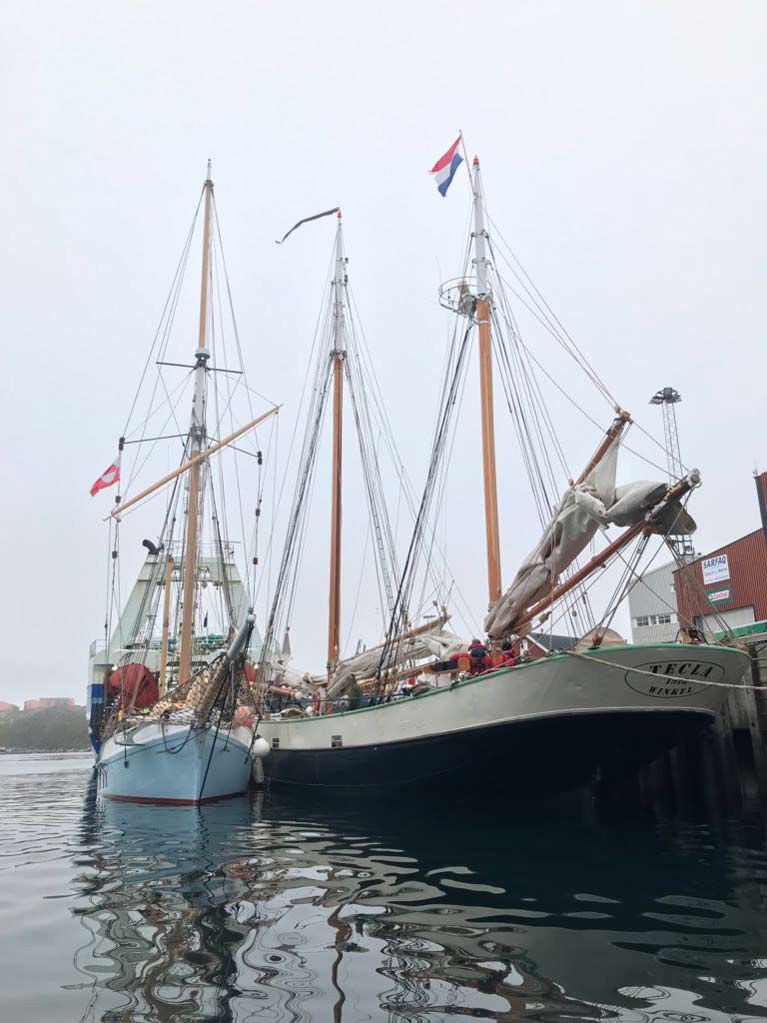 Ilen’s berth this morning in Nuuk was found alongside the hefty Dutch ketch Tecla
Ilen’s berth this morning in Nuuk was found alongside the hefty Dutch ketch Tecla
 Big town……after 19 days at sea or calling at very small coastal settlements, Nuuk is definitely “big town"
Big town……after 19 days at sea or calling at very small coastal settlements, Nuuk is definitely “big town"
The restored 56ft 1926-built traditional ketch Ilen lingered in the southwest Greenland port of Paamuit for the past couple of days while a vicious southerly gale blew itself out in the Labrador Sea writes W M Nixon. It was an opportunity to make do and mend on board, while onshore the crew of ten continued in their exploration of Greenland and the lives of the people who live in its more remote small ports. The opportunity was taken to re-stock the ship's stores. Ten hungry sailors can get through a prodigious amount of food, though unfortunately, it was impossible to find a local supply of potatoes to match their very best Irish spuds put aboard in Limerick, which the ship’s company had finished in a celebratory feast once Greenland waters were reached.
 The Last Supper (of Irish potatoes on Ilen). And very good they were too...
The Last Supper (of Irish potatoes on Ilen). And very good they were too...
Project Leader Gary Mac Mahon posted his thoughts as Ilen prepared to depart for her main objective on this Salmons Wake Educational Voyage: "It's time to depart the town and harbour of Paamiut. Simply; a sailor's longing for new places grows exponentially to the length of time spent holed-up at port - regardless of its charms.
Nuuk is next, approximately 150nm downwind and north from Paamiut. Today's southeasterly breeze will be at our backs, so all augurs well for a respectable ship’s speed as Ilen pushes onward north.
Yesterday's low cloud and rain has given way to sporadic sunshine, but the Ilen crew remain wrapped up while moving about the deck or bare streets of Paamiut.
Ilen has seen her Gardner engine enjoy a full service this morning - Mantas and Mike were the men for that vital task. Meanwhile, preparations for the coming run to Nuuk continue - food make-ready, rigging work and the stowing of Ilen's tender and outboard. Also, the anchor will see more robust deck lines embrace it, as we anticipate a rolling run north up the Labrador Sea - with decks awash from time to time.
And so, away we go.”
We wish them the best of luck. And in Nuuk, they will find a different world. Most of Greenland’s population lives in this bustling port town of many amenities provided by generous Danish Government support. Apart from hotels and restaurants, it claims to have three night clubs and there are bars where’s the musicianship of Ilen’s crew will be much appreciated, while they in turn - if seeking a total change - may welcome the fact that Nuuk is particularly proud of its 9–hole golf course……
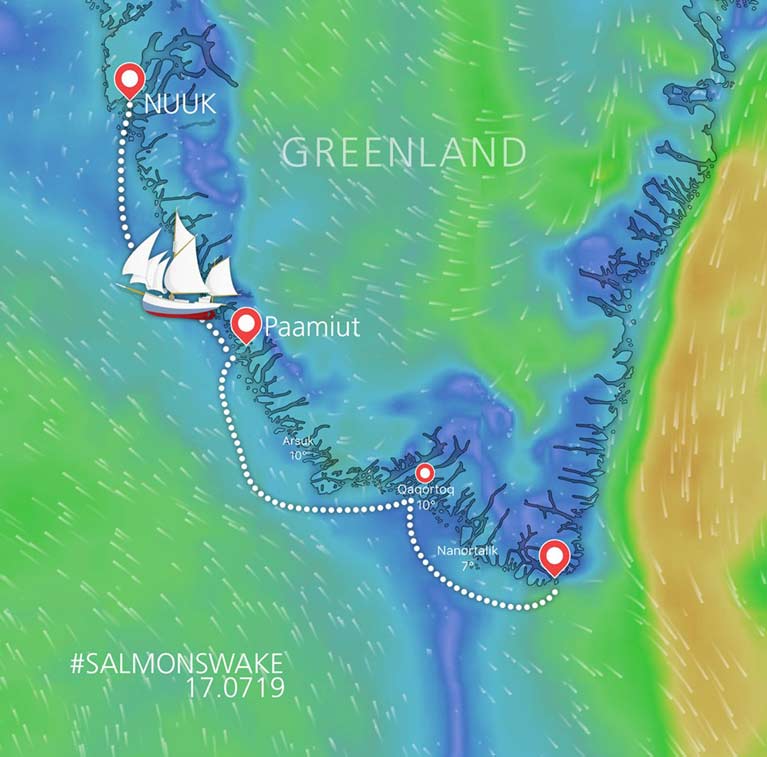 The final leg to Nuuk, the capital of Greenland
The final leg to Nuuk, the capital of Greenland
The restored 1926 Limerick trading ketch Ilen continues to make steady progress on her Salmons Wake voyage to the Arctic writes W M Nixon.
She is now port-hopping along the southwest coast of Greenland towards Nuuk, with the rough conditions experienced for thirty hours in rounding Cape Farewell last Wednesday increasingly just a part of the many and varied experiences being recalled.
A Greenland landfall pic.twitter.com/iVK4Zf5qKP
— Ilen Project (@ilenproject) July 13, 2019
Nevertheless, it was a severe test of ship and crew, and Project Leader Gary Mac Mahon wrote:
“The good ship Ilen made a swift westward passage across the magnificent North Atlantic, arriving in fine shape on Southern Greenland. Crucially, a small sailing vessel approaching this region must have in place a flexible if age-old navigational strategy for a purposeful rounding of the great Cape Farwell.
Although thought of as Greenland’s most southerly point, the Cape is actually the majestic south headland of Egger Island, which in turn is the southern island in the Nunap Isua Archipelago. It’s a very windy and watery world which throws up prodigious seas far out to sea - up to seventy nautical miles offshore on all sides of this vast and icy south-projecting Atlantic cape. Bergs and bergy bits are also a sea phenomenon for navigational consideration and pilotage.
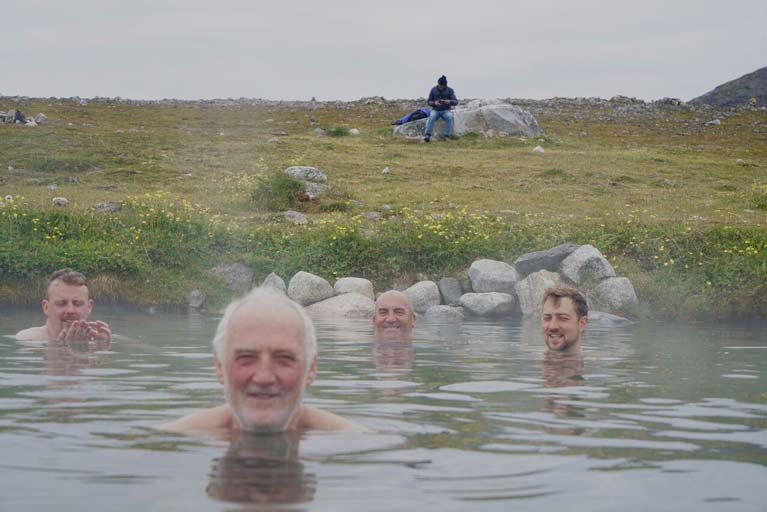 While Ilen’s crew were enduring the rough conditions off Cape Farewell, the thought of a relaxing swim and bath in natural hot springs pools on the island of Unartoq was way beyond their dreams. Yet a couple of days later, it came to pass……renowned musician Brendan Begley is lead swimmer.
While Ilen’s crew were enduring the rough conditions off Cape Farewell, the thought of a relaxing swim and bath in natural hot springs pools on the island of Unartoq was way beyond their dreams. Yet a couple of days later, it came to pass……renowned musician Brendan Begley is lead swimmer.
The confluence of these elemental forces and topographical features makes for a demanding dual process of navigation and seamanship, a high-latitude cape-rounding process which can be expected to extend for up to two long days and nights.
How it unfolded for the Ilen was quite challenging, finding ourselves amid the seas and winds we had hoped to have had the good fortune to avoid. But an expected easing of conditions had not materialised. Yet such is ocean sailing, and one must be prepared - at many levels - for these seaborn happenstance.
The Ilen and her crew held together nicely, and some mid-gale thoughts of heaving-to for sleep and hot food were eventually to subside in balance with the rising confidence with ship and crew. What’s not good with a life on dry biscuits for a days or two…..?.
Not a little of prayer was heard in the dark gale mumblings of Ilen’s crew on that memorable Cape rounding – the most vivid experience so far registered on this Educational Voyage of extraordinary memories and keen anticipation”.
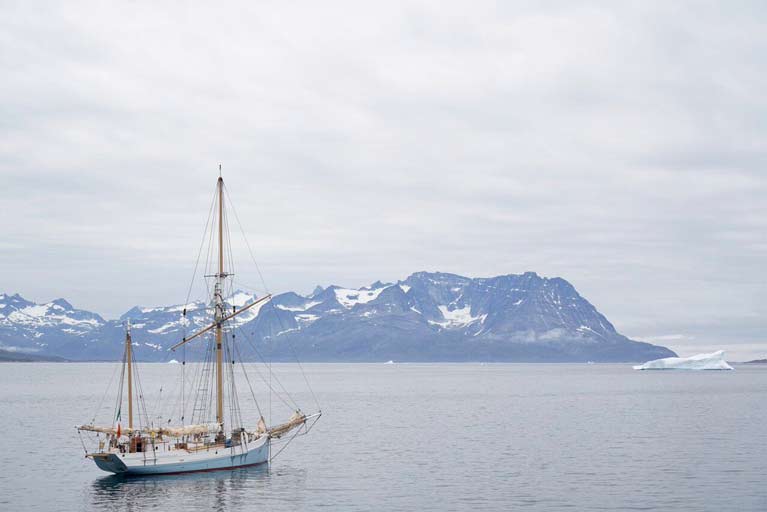 New places call – Ilen ready to depart off Nanortalik, where she was first welcomed to Greenland.
New places call – Ilen ready to depart off Nanortalik, where she was first welcomed to Greenland.
With the business of getting Cape Farewell put safely astern, Ilen and her crew have since been getting to know this vast island of Greenland and its isolated but vibrant little communities, making Nanortalik their first port of call.
In their coast passage-making northward, they have found time to visit remote anchorages on a majestic scale under snow-capped mountains, while a call to the island of Unartoq rewarded the crew with a welcome swim in natural hot spring water,
At the little settlement of Qaqortaq they found it was Festival Day for the local kayaks, deceptively basic craft of an ancient yet sophisticated type which, in skilled hands, can endure a remarkable variety of conditions at sea while the task of fishing continues.
Local kayaking races at Qaqortaq today - magnificent demonstration of skill and speed with these elegant frail skin craft. pic.twitter.com/r4S2HUerAf
— Ilen Project (@ilenproject) July 13, 2019
As for Ilen herself, progress continues to be good, and she has now reached Paamiut, halfway between Cape Farewell and Nuuk.
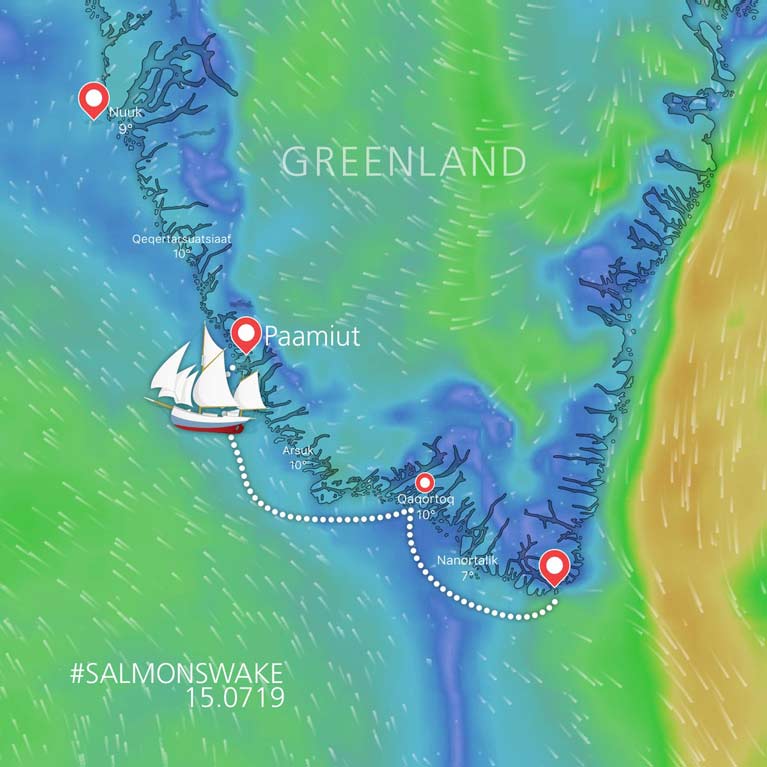 Ilen has now reached Paamiut, halfway from Cape Farewell to Nuuk
Ilen has now reached Paamiut, halfway from Cape Farewell to Nuuk  Solitary splendour. At a time when Dublin Bay was packed with boats in the Dun Laoghaire Regatta, Ilen had this vast bay in southwest Greenland entirely to herself. Photo: Gary Mac Mahon
Solitary splendour. At a time when Dublin Bay was packed with boats in the Dun Laoghaire Regatta, Ilen had this vast bay in southwest Greenland entirely to herself. Photo: Gary Mac Mahon
Ilen Experiences Climate Change in Greenland
After an arduous voyage of constant fog and one serious storm en route to Greenland, Ireland’s oldest sailing trading ketch Ilen has encountered its first clear evidence of climate change.
“When our skipper, Paddy Barry, was approaching Cape Farewell on Greenland’s southern tip back in 2001, he was met with ice,” crew member and Kerry musician Breanndán Ó Beaglaoich told Afloat by satellite phone.
“We had no such problems, nor have we seen any snow on any hills – Greenland is purely green,” he said. “If anyone doubted climate change’s impacts, they only have to come north.”
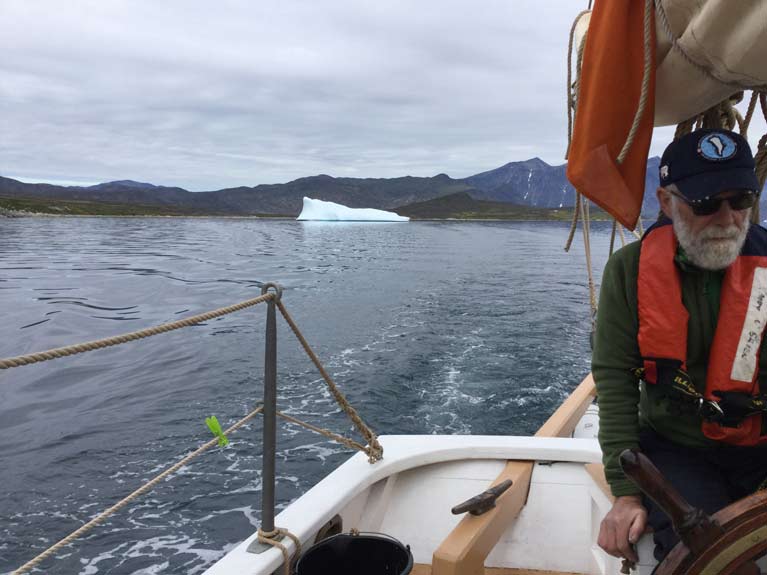 Seamus O’Byrne (Ilen Skipper Paddy Barry’s secret twin) in Greenland. Ice and snow much is less than it was on Barry's previous visit in 2001 Photo: Breanndán Ó Beaglaoich
Seamus O’Byrne (Ilen Skipper Paddy Barry’s secret twin) in Greenland. Ice and snow much is less than it was on Barry's previous visit in 2001 Photo: Breanndán Ó Beaglaoich
The 1200 nautical mile voyage by the Ilen from the Shannon estuary up the west Greenland coast is intended to follow the migratory route of the wild Atlantic salmon. The restored ketch, originally built over 90 years ago by global circumnavigator Conor O’Brien, from Limerick, had proved its worth since it left the Shannon estuary in late June, Ó Beaglaoich says.
Limerick graphic artist Gary McMahon, who spearheads the community project to rebuild the vessel, is on board, along with Barry, Ó Beaglaoich, Mike Grimes, Mantas Seskanskis, James Madigan, Ronan O Caoimh, Mick Ruane, Seamus O’Byrne and Justin McDonagh.
“We had eight to nine days of fog, and we saw neither sun, moon, stars or any other boat, “Ó Beaglaoich recalls. “One of our crew joked we could have been going around in circles, were it not for our navigation.”
“We were about 300 nautical miles off the Greenland coast when we hit a storm, and I think it was probably the worst seas I have ever experienced,” Ó Beaglaoich, who rowed from Ireland to Spain in a Kerry naomhóg, says.
“At one point, Paddy Barry, who is 76 years of age, sat up in his bunk in the middle of the storm, and exclaimed that it was great to be alive,” Ó Beaglaoich says. “My answer was that it was great to be alive, but I’d prefer to be alive somewhere else! “
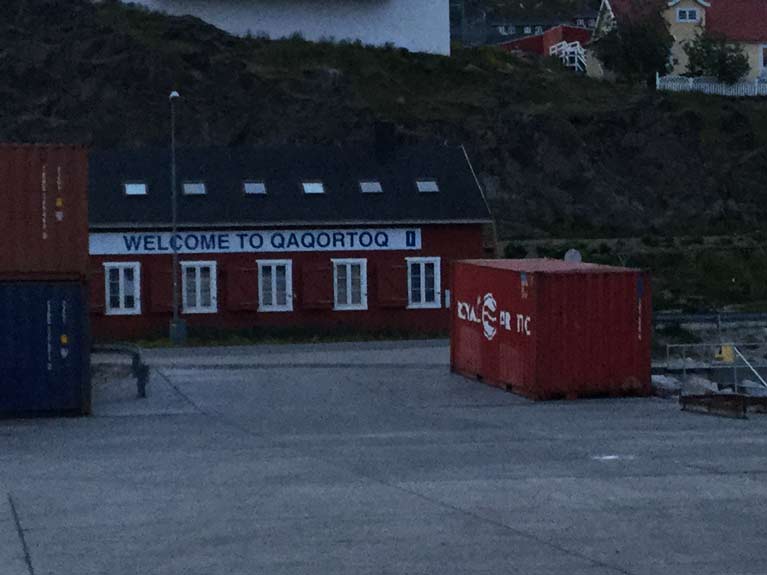
“When we arrived into Cape Farewell, the Inuit people who welcomed us were so kind and compassionate, and I have discovered that music and being at sea are my two favourite things in life,” he said.
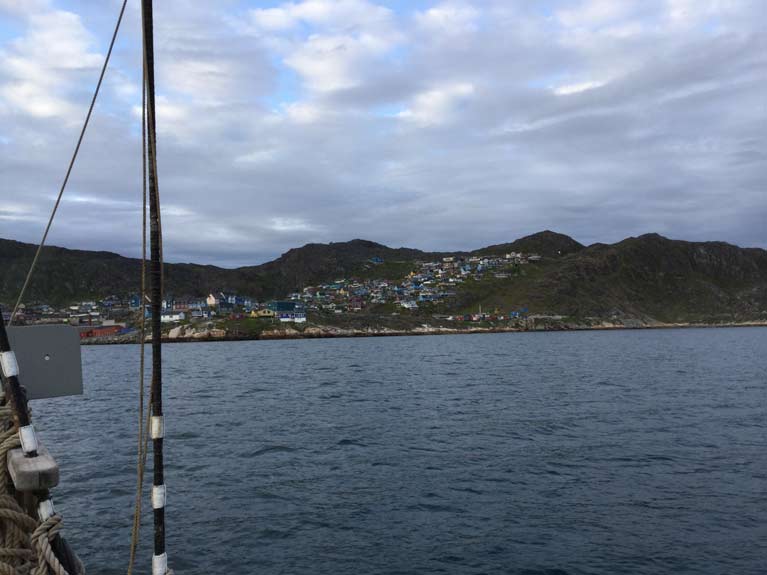
“The Ilen hasn’t done a voyage like this since it was built by O’Brien in west Cork back in the 1920s and taken to the Falkland Islands, so the ketch really proved its worth,” he said.
The crew will deliver a traditional Limerick Shannon salmon-fishing cot which the Ilen boatbuilding school constructed, as a gift from Limerick city to the people of Nuuk, Greenland’s capital city.
The ultimate destination is Disko Bay, western Greenland’s largest open bay, which has been gradually warming since 1997.
Last month, Irish adventurer Jamie Young set sail for Greenland onboard his 15m aluminium yacht Killary Flyer, as part of a two-year Dutch-Irish film project to document the impact of climate change.
Historic Ketch Ilen Reaches First Port in Greenland After 11-Day Voyage from Limerick
After experiencing every sort of condition from Force 8 winds to near calms, the 56ft 1926-built restored ketch Ilen of Limerick has reached her first port in Greenland to conclude 11 days of Transatlantic ocean voyaging, having successfully negotiated the challenging waters around the majestic Arctic super-island’s southerly headland of Cape Farewell.
As Afloat previously reported, although Cape Farewell and its surrounding coastline is totally barren, Ilen’s crew are now relaxing on Greenland’s southwest coast in the relative comfort of Nanortalik (it means “Place of the Polar Bears”), a port town with 1,337 inhabitants which is Greenland’s most southerly municipality. The next stage of the voyage will be northwards towards the Greenland capital of Nuuk, but for now the fact that the hazards of Cape Farewell have been successfully put astern through difficult conditions, in which the Conor O’Brien trading ketch handled very well, is a matter for celebration by the crew of ten and their many supports in Ireland and worldwide.
The Limerick ketch Ilen on her Salmons Wake voyage to southwest Greenland had got to within 200-miles of the huge island’s most southerly headland, Cape Farewell, towards midnight last night (Monday). With her speed held back to 6 knots in order to avoid arriving in the region until a local gale has blown itself out through today, her crew are now considering their options, with the inner channel of Prins Christiansund becoming a favoured choice. Reports indicate that this steep-sided Sound - which can provide safe passage inside the many hazards of Cape Farewell – is reasonably clear of ice, proving much safer access to the coast of southwest Greenland and next stage of the voyage, the passage north to Nuuk.
 Ilen’s position towards midnight last night, slightly over a week after departing seaward past Loop head
Ilen’s position towards midnight last night, slightly over a week after departing seaward past Loop head
Limerick Ketch Ilen Makes Excellent Progress in Mid-Atlantic on Passage Towards Greenland
The 56ft Limerick traditional ketch Ilen, on her Salmon’s Wake voyage from the Shannon Estuary to Greenland (2019 is the Year of the Salmon), has been making good progress since heading seaward past Loop Head on Monday afternoon writes W M Nixon. In fact, at the moment the sailing is so good, running in a 20-knot easterly, that the crew may ease off the speed in order not to arrive at Greenland’s most southerly point of Cape Farewell any earlier than next Wednesday, when weather conditions at the iconic headland are expected to have improved from the current inclement situation.
The voyage outward has so far gone well, so much so that the most rugged part came in the first 12 hours after passing Loop Head. Generally, the Atlantic has been in a fairly benign mood, but as they come within the weather ambit of Greenland itself, more variable and possibly adverse conditions become increasingly possible.
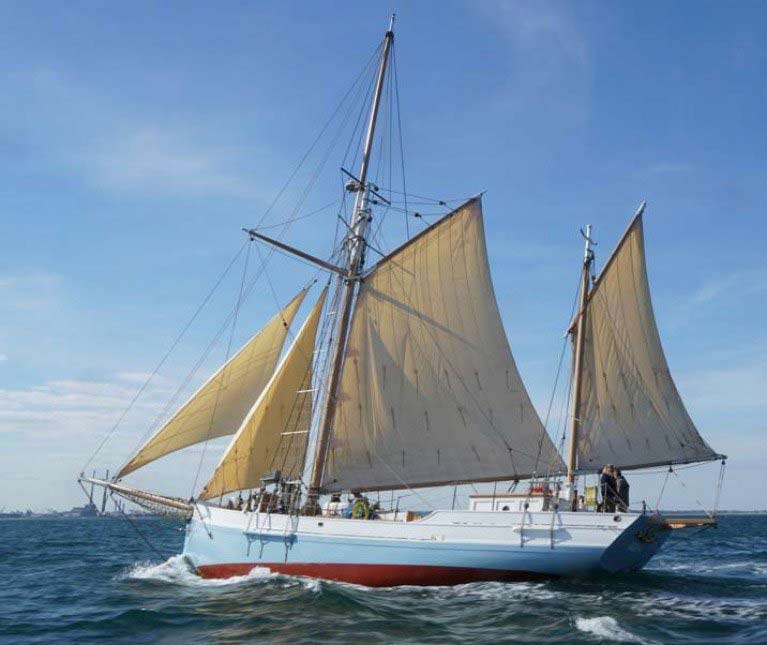 Ilen going well. Out in mid-Atlantic on passage to Greenland, progress is currently so good that her crew may have to ease back on speed in order not to reach Cape Farewell until local conditions at the great headland have become more favourable
Ilen going well. Out in mid-Atlantic on passage to Greenland, progress is currently so good that her crew may have to ease back on speed in order not to reach Cape Farewell until local conditions at the great headland have become more favourable
The long Shannon Estuary and a strong ocean-going ebb tide enabled the restored traditional trading ketch Ilen of Limerick to make good progress westward yesterday evening on the voyage to Greenland despite a near-gale from ahead which came in with a frontal system from the Atlantic writes W M Nixon.
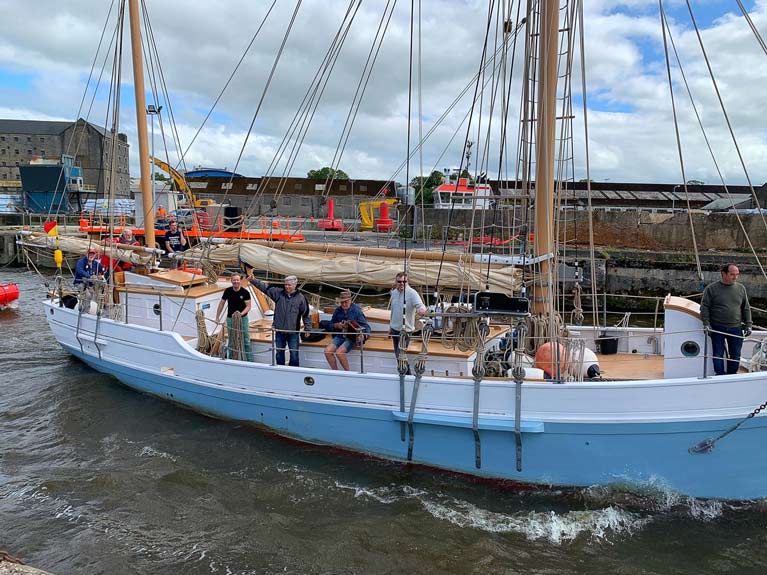 “We’re on our way!” Exiting through the sea lock immediately gets you into the ebb tide sweeping down the mighty Shannon Estuary
“We’re on our way!” Exiting through the sea lock immediately gets you into the ebb tide sweeping down the mighty Shannon Estuary
As Afloat reported earlier, Ilen departed from Limerick as planned despite brisk conditions late on Sunday afternoon. But with a softening of the weather and fair winds for the Greenland passage expected, it made sense to overnight within the outer estuary at anchor in the shelter off Carrigaholt, a special place for project leader Gary MacMahon as the most conspicuous building at the quay is the former castle of the Mac Mahons.
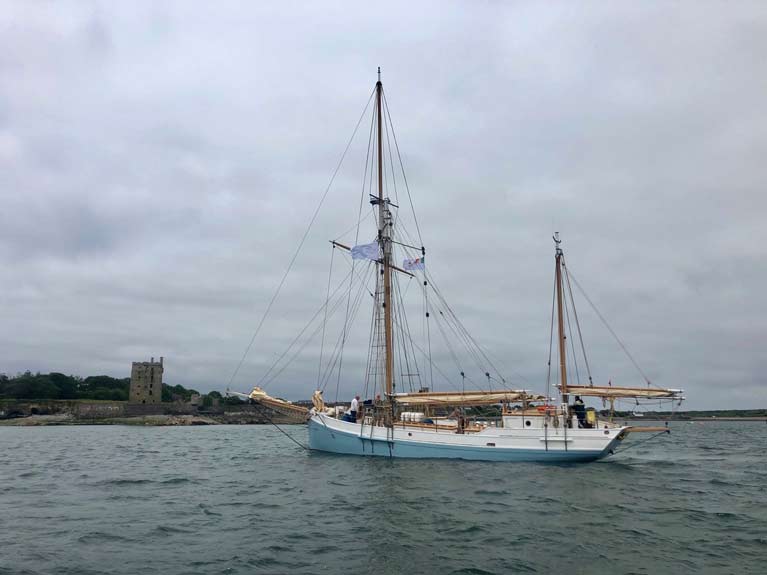 Already well westward – Ilen at Carrigaholt Castle this morning. Photo: Gary MacMahon
Already well westward – Ilen at Carrigaholt Castle this morning. Photo: Gary MacMahon
Although the stop was brief, it provided an opportunity for a raft-up with the locally-built Shannon Hooker re-creation, the famous Sally O’Keeffe. But there’s a strong sense of purpose to this initial stage of the Salmons Wake Educational Voyage, and Ilen was planning to head seawards at 3.0pm this afternoon.
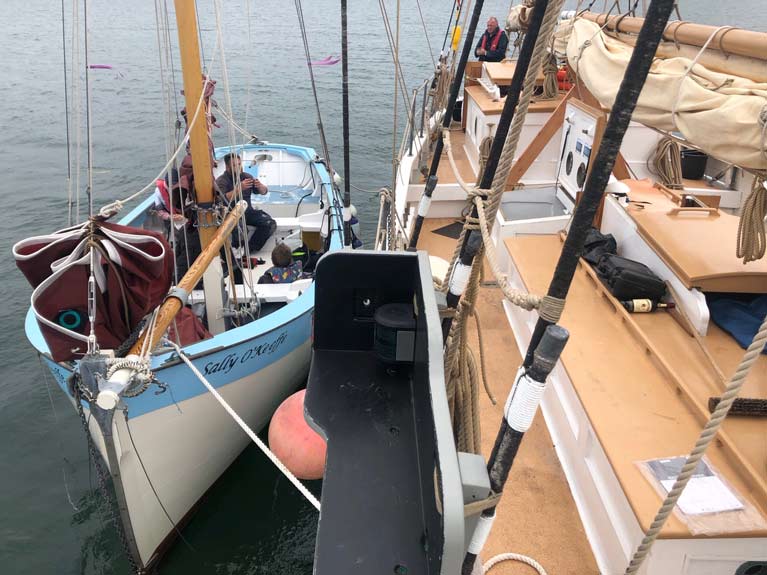 Visitors to wish them well – the Shannon Hooker re-creation Sally O’Keeffe of Querrin alongside Ilen at Carrigaholt this morning. Photo: Gary MacMahon
Visitors to wish them well – the Shannon Hooker re-creation Sally O’Keeffe of Querrin alongside Ilen at Carrigaholt this morning. Photo: Gary MacMahon




























